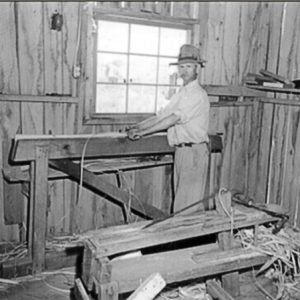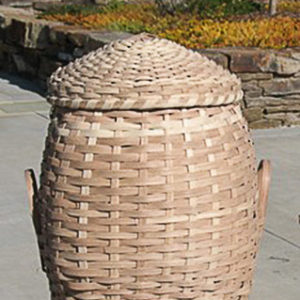calsfoundation@cals.org
Gibson Baskets
The history of the Gibson family of basket makers—which, as of 2009, has produced split white oak baskets for four generations—parallels the history of basket making in the United States. The split white oak basket is distinctive to the Ozarks and is woven from thin, flexible splints used as ribs and weavers. The Gibson family has continued the tradition of making baskets using handmade tools and natural materials. The characteristics of a Gibson basket are a heavy hand-carved handle, herringbone weave on the flat rectangular basket bottom, and construction without nails.
Christopher Columbus “Lum” Gibson (1865–1947) reportedly began making baskets in the 1880s and is said to have had a blind man as a teacher. His workbaskets were sold door to door or at the marketplace in towns around the Fayetteville (Washington County) and Springdale (Washington County) area. His son, George Harrison Gibson (1890–1979), carried on the family tradition while working out of a woodshed in his back yard in Spring Valley just north of Fayetteville. Between 1950 and 1952, U.S. senator J. William Fulbright and architect Edward Durell Stone collaborated to design and make modern bent-wood furniture. An element of their design included double-woven seats and backs of split white oak by George Gibson, who was the “premier split oak basket maker of the Ozarks.” George Gibson was one of the first Arkansas basket makers to achieve national recognition by demonstrating his basket-making process for the Smithsonian Institution’s Fourth Annual Festival of American Folklife held in Washington DC in 1970. The following year, he was called upon by the Smithsonian again to represent the “Dixieland region” of the United States at the Visit US Pavilion on St. Helen’s Island, Montreal, Canada. A friend urged George Gibson to create a collection of all his basket types, including some that had not been produced for many years. The University of Arkansas Museum collections in Fayetteville acquired this collection in 1979. George Gibson’s baskets are also in the collection of the Smithsonian Institution’s Museum of American History in Washington DC.
Don Richard Gibson (b.1938) was next in line; while George Gibson taught basket making in Bentonville (Benton County), Eureka Springs (Carroll County), Winslow (Washington County), Jasper (Newton County), and Evansville (Washington County), the family kept up with production at home. The men would customarily do the heavy work of felling trees, splitting logs, and making splints while others in the family took on the task of basket weaving. Don Gibson’s two brothers—Harvey Gibson (1925–1994) and Earl Gibson (b.1932)—as well as his two sisters—Juanita Gibson (1923–1999) and Thelma Gibson (1933–1993)—are known to have made baskets while growing up.
Don Gibson passed the basket-making tradition on to the fourth generation, his son, Terry Lynn Gibson (b.1960). Terry Gibson reports that he has been involved in basket making all his life. By high school age, he was weaving all kinds of baskets, making thirty different types and sizes over the course of his career. In 1986, Terry Gibson made fifty baskets for the National Governors’ Association New Governors’ Seminar and the “Good Work Arkansas Campaign” in Little Rock (Pulaski County). The baskets were filled with Arkansas products and presented as gifts to visiting delegates.
Gibson baskets range from small to large, serving a wide variety of utilitarian uses. The Gibson split white oak baskets were first sold locally to farmers as containers for feed, eggs, and garden produce. While baskets continue to serve utilitarian and social purposes, they also serve as decorative elements in homes.
For additional information:
Edminsten, Robert. “Basket Maker Practices Rare Art.” Arkansas Gazette. April 30, 1972, p. 6E.
Gibson Baskets. http://www.gibsonbaskets.com/ (accessed April 11, 2022).
Hoffman, Margaret J., Johnnie L. Gentry Jr., Mary E. McGimsey. Ozark Split Oak Baskets. Fayetteville: University of Arkansas Museum, 1980.
Hunting, Mary Ann. “From Craft to Industry: Furniture Designed by Edward Durell Stone for Senator Fulbright.” Antiques, May 2004, 110–119.
Sutton, Leslie. “Gibson Baskets: A Long Ozark Tradition Preserved.” Northwest Arkansas Times. March 31, 1978, p. 19.
Alan DuBois
Benton, Arkansas
 Arts, Culture, and Entertainment
Arts, Culture, and Entertainment Business, Commerce, and Industry
Business, Commerce, and Industry George Gibson
George Gibson  Gibson Hamper
Gibson Hamper 




Thank you for this well-written article. My grandpa is Glen Curry, who is now eighty-six years old. He is the son of Nancy Gibson. My grandpa used to make baskets on a weekly basis when I was younger. I would watch how strong he was as he would split the timber. I remember him soaking the timber and splits to make them easier to work with. He had everything needed in the backyard and most of it was handmade tools, such as what he called the wood horse. We just had a family reunion, and I saw Earl Gibson, who is eighty-one. I went to Winslow and stopped at an old rock gift shop. I was happy to see some of Earl’s baskets in the shop. My grandpa and I would sell baskets all throughout the Ozarks, which included selling baskets in Eureka Springs, in Winslow when there was no Highway 540, at UA functions, and at gift shops on Dickson Street. I wrote this as a token of my love to my grandpa, Glen Curry, and to some of my great-great-uncles, Denver Tooter Gibson and Bill Gibson. I am Laurena Patton, daughter of Patricia Curry, granddaughter of Glen Curry, great-granddaughter of Nancy Gibson.
I’ve been collecting Gibson baskets since 1973. At one time I had about 100. I’ve given them to family and friends, so now have a little over 40. I should add that George Gibson made a bassinet for my newborn son in 1973. Lined with a foam mattress, lined with quilted flannel, it was perfect.
Everyone in my family knows about and enjoys my Gibson baskets, many of which were purchased in Brentwood, Arkansas.